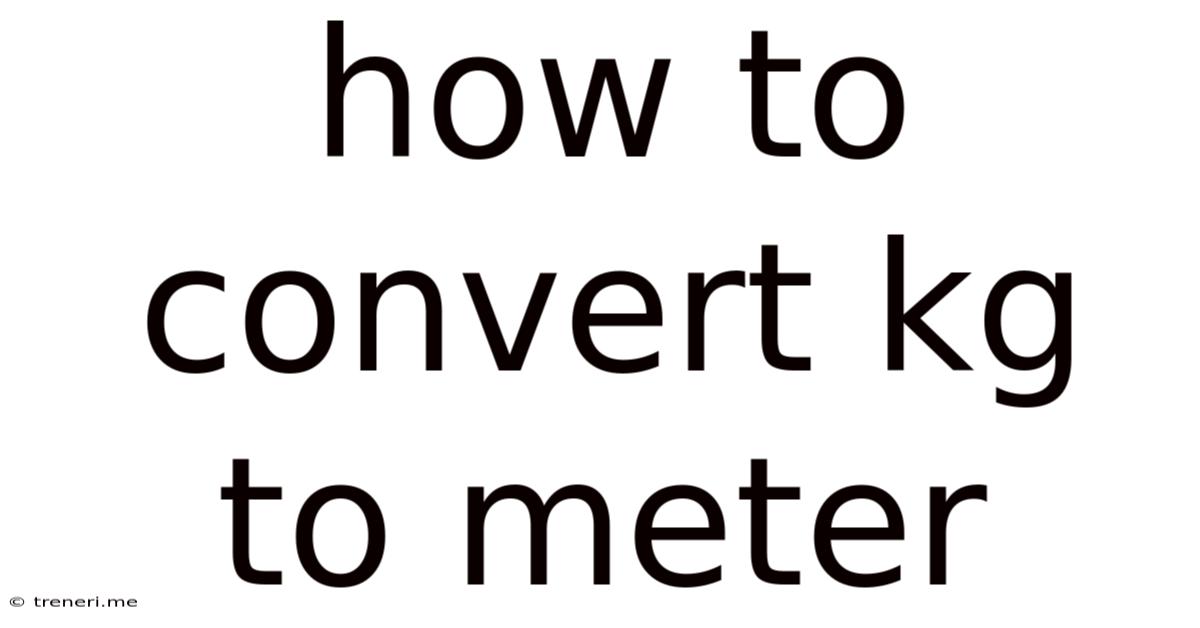How To Convert Kg To Meter
Treneri
May 12, 2025 · 4 min read

Table of Contents
It's impossible to directly convert kilograms (kg), a unit of mass, to meters (m), a unit of length. These are fundamentally different physical quantities. Attempting a direct conversion is like trying to convert apples to oranges – it simply doesn't make sense. However, there are scenarios where kilograms might indirectly relate to meters, and this article will explore those situations, clarifying the misconceptions and providing practical examples.
Understanding the Difference: Mass vs. Length
Before we delve into indirect relationships, let's firmly establish the distinction between mass and length.
-
Kilograms (kg): A unit of mass, representing the amount of matter in an object. It measures inertia, the resistance of an object to changes in motion. A heavier object has more mass and requires more force to accelerate.
-
Meters (m): A unit of length, representing the distance between two points. It measures spatial extent in one dimension.
The fundamental difference means there's no single conversion factor. You cannot use a simple formula like "1 kg = X m."
Indirect Relationships: Where kg Might Inform Meter Calculations
While a direct conversion is impossible, kilograms can be relevant in scenarios where length is determined indirectly. Let's explore these contexts:
1. Density and Volume: Calculating Length from Mass
If you know the density of a material (mass per unit volume) and its mass in kilograms, you can calculate its volume. Depending on the shape of the object, you can then use that volume to determine at least one dimension in meters.
Formula:
Density (ρ) = Mass (m) / Volume (V)
Rearranging for Volume:
V = m / ρ
Example:
Let's say you have a cube of aluminum weighing 27 kg. The density of aluminum is approximately 2700 kg/m³.
-
Calculate the volume: V = 27 kg / 2700 kg/m³ = 0.01 m³
-
Find the side length: Since it's a cube, the volume is side³ (V = s³). Therefore, the side length (s) is the cube root of the volume: s = ³√0.01 m³ ≈ 0.215 m.
This example demonstrates how knowing the mass, density, and shape allows for the indirect calculation of length. Different shapes will require different formulas to relate volume to length. For a cylinder, you'd need both the volume and radius (or diameter) to find the height. A sphere needs just the volume to find the radius.
2. Linear Mass Density: Length from Mass of a Wire or Rod
For a long, thin object like a wire or rod, we use linear mass density (mass per unit length). If you know the linear mass density (often denoted as λ or μ), you can calculate the length from its mass.
Formula:
Linear Mass Density (λ) = Mass (m) / Length (L)
Rearranging for Length:
L = m / λ
Example:
Suppose you have a copper wire weighing 5 kg with a linear mass density of 0.1 kg/m.
- Calculate the length: L = 5 kg / 0.1 kg/m = 50 m.
This demonstrates how linear mass density directly connects mass to length for slender objects.
3. Weight and Material Properties: Estimating Length in Specific Contexts
In some situations, the weight (force due to gravity) of an object might be known, along with material properties that allow estimations of length. However, this is indirect and depends on various factors. For instance, knowing the weight of a hanging cable and its material's tensile strength might allow an engineer to estimate the cable's length. The weight gives an estimate of the mass, which then gets linked to the length through structural equations dependent on cable material and design. This is a much more complex engineering calculation and outside the scope of simple conversions.
4. Misconceptions and Common Errors to Avoid
It's crucial to understand the limitations and avoid common mistakes:
-
Incorrect Assumptions: Never assume a direct conversion exists without considering the context and additional information. Always check if density or linear mass density is provided.
-
Units: Ensure consistent units throughout your calculations. If density is given in g/cm³, you'll need to convert it to kg/m³ before applying the volume calculation.
-
Shape: Understanding the object's shape is essential for relating volume to length. Different formulas apply to cubes, spheres, cylinders, etc.
Conclusion: The Importance of Context in Measurements
The conversion from kilograms to meters isn't a straightforward calculation but involves an understanding of the underlying physical properties and the relationships between different physical quantities. The examples provided illustrate how mass (kg) can indirectly provide information enabling the calculation of length (m), often requiring additional information like density or linear mass density. Always carefully consider the context, utilize appropriate formulas, and maintain consistent units for accurate results. Remember, mass and length are distinct quantities, and attempting direct conversion is fundamentally incorrect.
Latest Posts
Latest Posts
-
400 Cm Is How Many Meters
May 12, 2025
-
Cash For Life Lump Sum After Taxes
May 12, 2025
-
Round 324 To The Nearest Hundred
May 12, 2025
-
10 1 Compression Ratio To Psi
May 12, 2025
-
Quantas Semanas Tem O Ano De 2024
May 12, 2025
Related Post
Thank you for visiting our website which covers about How To Convert Kg To Meter . We hope the information provided has been useful to you. Feel free to contact us if you have any questions or need further assistance. See you next time and don't miss to bookmark.